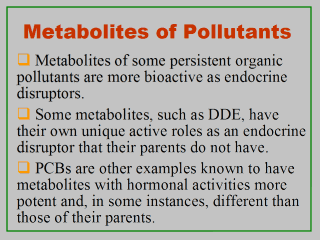| front |1 |2 |3 |4 |5 |6 |7 |8 |9 |10 |11 |12 |13 |14 |15 |16 |17 |18 |19 |20 |review |
 |
Some persistent
organic pollutants have one or more metabolites that are far more bioactive
in interfering with certain functions of the endocrine system. A good
example is p,p’-DDE, which is a breakdown product of the infamous
organochlorine pesticide DDT. Although p,p’-DDE might not be any more
biologically available than its parent compound, it does have its own unique
active roles as an endocrine disruptor. Unlike DDT, the DDE metabolite is
known to have the ability to interfere with male sexual development,
including deactivation of the male sex hormone testosterone (Kelce et al.,
1995). Polychlorinated biphenyls (PCBs) are another group of persistent organochlorines known to have metabolites with hormonal activities more potent than those of their parents. Studies supporting this assertion include the observation by Andersson et al. (1999), in which the estrogenic activities of four structurally diverse PCBs and five of their hydroxylated derivatives (OH-PCBs) were examined. This study involved a series of in vitro assays in which the PCB compounds were tested for the ability to induce the proliferation of MCF-7 human breast cancer cells and for the ability to express the vitellogenin gene in rainbow trout hepatocytes. In both species, OH-PCBs were shown to be more hormonally active than their parent PCBs, with one being almost as potent as the natural estrogen. In another study, Cheek et al. (1999) examined several organochlorines, including DDT and PCBs, for their binding affinity to the human thyroid hormone receptors and the thyroid hormone transport proteins. That study showed that only the OH-PCB metabolites were bound to the thyroid hormone receptors. |